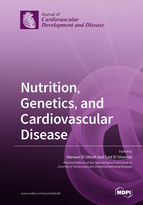Nutrition, Genetics, and Cardiovascular Disease
A special issue of Journal of Cardiovascular Development and Disease (ISSN 2308-3425).
Deadline for manuscript submissions: closed (31 January 2020) | Viewed by 29592
Special Issue Editors
Interests: clinical nutrition; obesity; sarcopenic obesity; type 2 diabetes; eating disorders; weight-related diseases; body composition; weight cycling; physical activity; energy expenditure
Special Issues, Collections and Topics in MDPI journals
Special Issue Information
Dear Colleagues,
The Journal of Cardiovascular Development and Disease (JCDD) is launching a Special Issue on “Nutrition, Genetics, and Cardiovascular Disease”. JCDD is a peer-reviewed online journal, in its fourth year of existence, which publishes review articles and original works on cardiovascular development and disease.
It is well documented that cardiovascular disease is a major cause of death worldwide, in which genetic and environmental factors seem to play a determinant role. In fact, several dietary factors and nutritional-related diseases (i.e., obesity, type 2 diabetes) are strongly associated with cardiovascular diseases. In addition, genome-wide association studies have also identified numerous genomic loci that determine susceptibility to cardiovascular events. Therefore, nutrition and genetics seem to interact in predisposing an individual to cardiovascular diseases.
This Special Issue will provide a platform for the presentation of recent advances in knowledge on nutrition, genetics, and cardiovascular disease coming from diverse scientific disciplines.
Prof. Marwan El Ghoch
Dr. Said El Shamieh
Guest Editors
Manuscript Submission Information
Manuscripts should be submitted online at www.mdpi.com by registering and logging in to this website. Once you are registered, click here to go to the submission form. Manuscripts can be submitted until the deadline. All submissions that pass pre-check are peer-reviewed. Accepted papers will be published continuously in the journal (as soon as accepted) and will be listed together on the special issue website. Research articles, review articles as well as short communications are invited. For planned papers, a title and short abstract (about 100 words) can be sent to the Editorial Office for announcement on this website.
Submitted manuscripts should not have been published previously, nor be under consideration for publication elsewhere (except conference proceedings papers). All manuscripts are thoroughly refereed through a single-blind peer-review process. A guide for authors and other relevant information for submission of manuscripts is available on the Instructions for Authors page. Journal of Cardiovascular Development and Disease is an international peer-reviewed open access monthly journal published by MDPI.
Please visit the Instructions for Authors page before submitting a manuscript. The Article Processing Charge (APC) for publication in this open access journal is 2700 CHF (Swiss Francs). Submitted papers should be well formatted and use good English. Authors may use MDPI's English editing service prior to publication or during author revisions.
Keywords
- nutrition
- genetics
- cardiovascular diseases
- obesity
- GWAS
- sarcopenic obesity
- type 2 diabetes
- epigenetics
- metabolic syndrome








